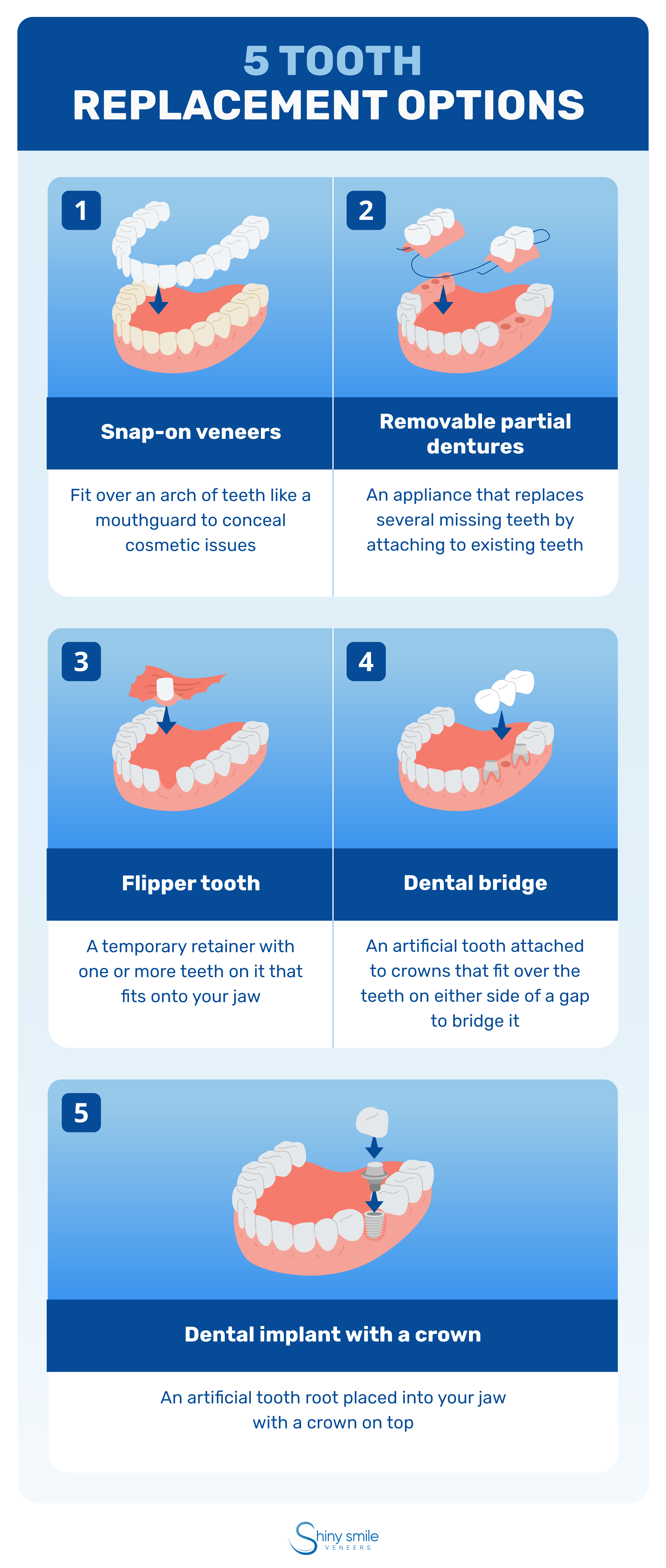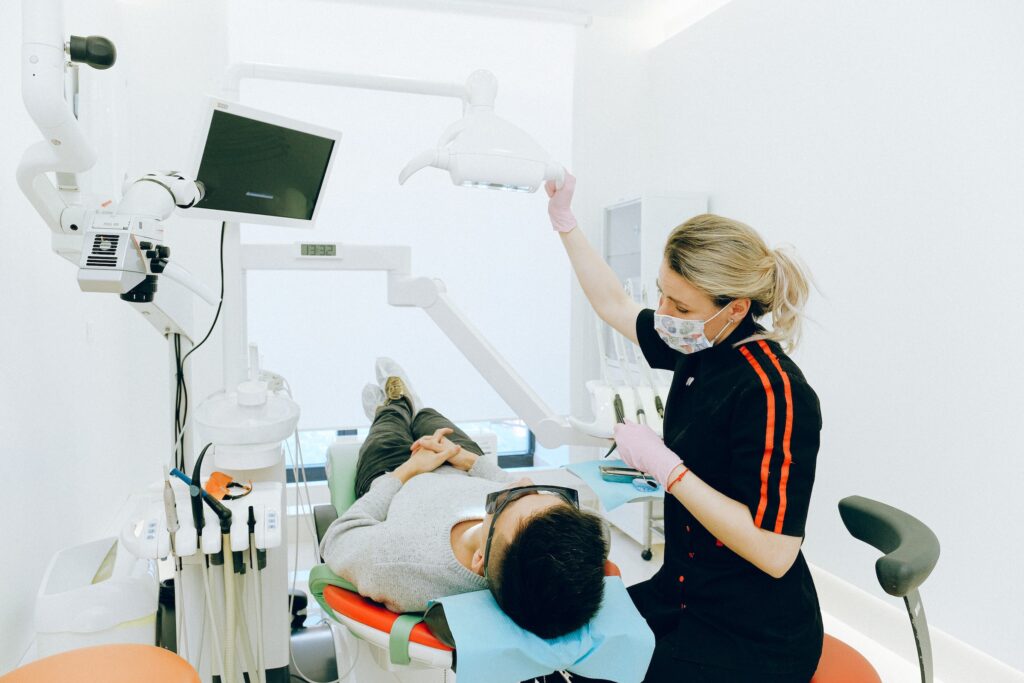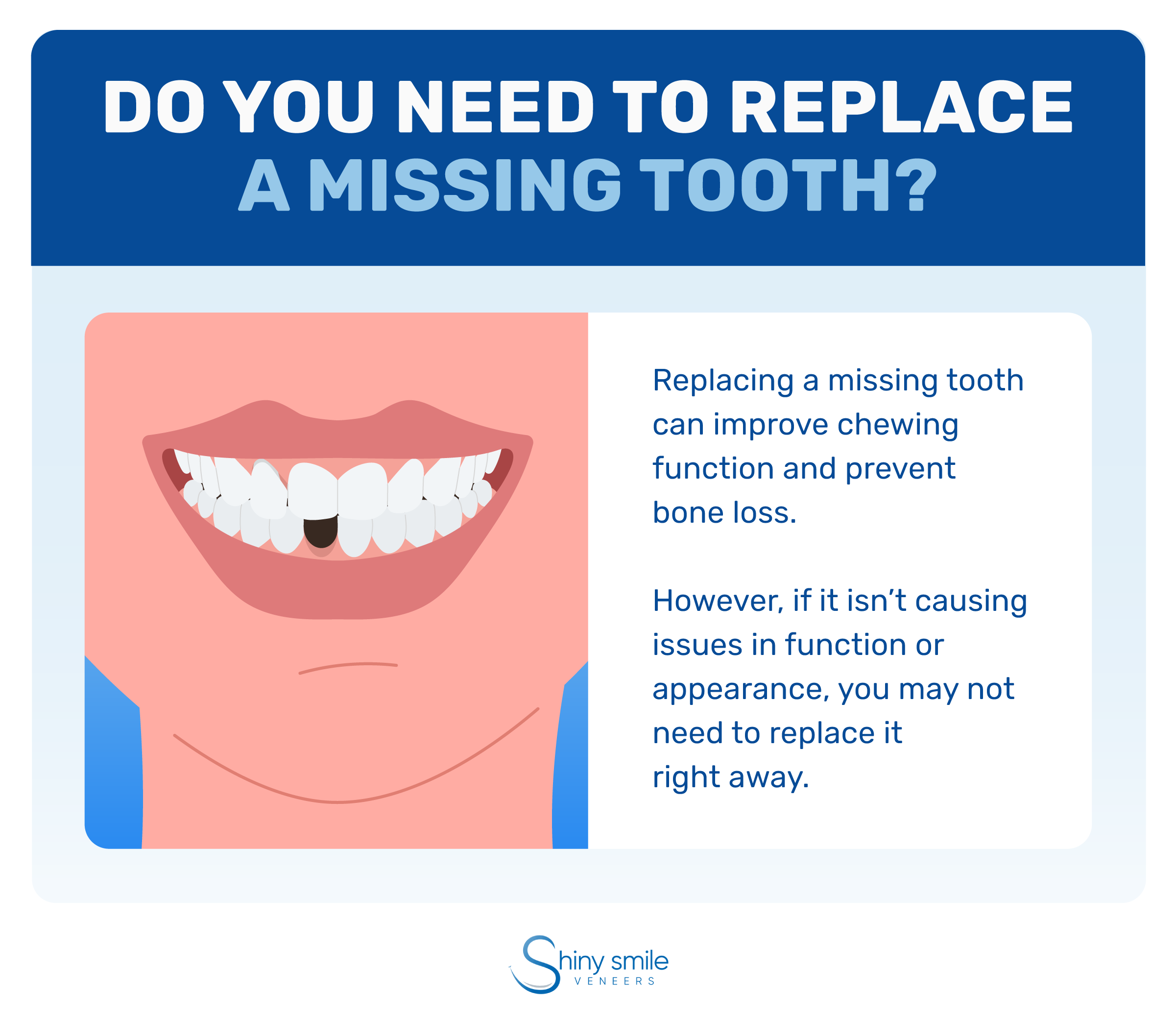
A missing tooth can cause you to be self-conscious or may even prevent you from chewing your food properly. While you might think that expensive dental implants offer the best option for replacing missing teeth, there are other more affordable alternatives that may be better for you.
This post covers your options for replacing or concealing a missing tooth, what the procedures involve, and how much they cost.
5 Tooth Replacement Options
If you have experienced tooth loss for one reason or another, you may be able to choose from the following treatment options.

1. Snap-on Veneers
Snap-on veneers fit over your natural teeth like a mouthguard, giving you a perfect smile. Although they are not the right choice if you have many missing teeth, snap-ons can effectively conceal a missing tooth or two.
A big advantage of snap-on veneers is that you can fit them at home using a kit, so you don’t have to go to a dental office or risk any complications. You can eat soft food while wearing your removable veneers, but hard food may dislodge or damage them.
Because they are cosmetic, veneers may not be covered by your insurance. However, snap-ons are affordable, with a full set of Shiny Smile Veneers costing $570 and lasting one to five years with regular use.
- Pros: An affordable way to conceal a missing tooth without going to the dentist
- Cons: Not the right option for multiple missing teeth or severe dental health issues
2. Removable Partial Dentures
Partial dentures are a removable appliance that replaces one or several missing teeth. They’re similar to a full set of dentures, but they have clasps that hook around your existing teeth. Although partial dentures improve chewing function, you should stick to soft foods while wearing them.
The process of getting dentures usually takes several appointments over a few weeks, plus an additional few weeks to get used to the dentures and make any adjustments. It is not unusual to experience a little soreness or irritation as you get used to the appliance. A full treatment plan involves the following steps:
- The dentist takes a series of impressions and measurements of your teeth and jaw.
- These are used to make models of the denture that you can try for fit, color, and shape.
- Once the fit is right, a final partial denture is made, followed by any adjustments as needed.
Depending on your specific case, you may be able to get an implant-supported partial denture. This kind doesn’t snap in and out and can only be removed by a dentist.
Partial dentures typically cost between $500 and $1,500 but are often covered by dental insurance. The appliance needs to be reevaluated every five years to make sure it is in good condition and still fits properly.
- Pros: Durable and modifiable if more teeth are lost; likely covered by insurance
- Cons: Typically needs to be removed overnight and cleaned daily
3. Flipper Tooth
A flipper tooth can fit along the roof of your mouth or simply sit on your lower jaw. Functioning as only a temporary partial denture, it consists of a removable retainer with one or more artificial teeth attached.
You can eat soft foods with a flipper tooth, but you should take care while eating and make sure to remove it nightly for cleaning.
One of the less expensive tooth replacement options, a flipper tooth typically costs between $300 and $500 and may be covered by insurance. This type of prosthesis is intended to be a temporary solution while you wait for a more permanent treatment. While flipper tooth dentures can last years, they’re not particularly durable and may need to be replaced after a few months.
- Pros: An affordable temporary option that often looks natural
- Cons: Typically not durable and therefore not best for long-term use

4. Dental Bridge
Dental bridges replace a missing tooth by “bridging the gap” using adjacent teeth on either side. Two types of dental bridges are suitable for a missing tooth:
- Maryland dental bridge: Used to replace front teeth, this type of bridge has wings that are bonded to the back of neighboring teeth to hold it in place.
- Fixed dental bridge: The fixed bridge has dental crowns (artificial teeth) on either side of the missing tooth to hold it in place.
While dental bridges can restore chewing function, hard foods can damage them.
The exact procedure depends on the type of bridge, but usually requires two dentist visits:
- For a Maryland bridge, your dentist will take dental impressions during the first visit and then bond the bridge to your teeth during the second visit.
- For a fixed bridge, the first visit requires the reshaping of the abutment teeth on either side by removing some of your natural enamel. This step requires anesthesia. Your dentist may then place a temporary bridge, which will be replaced by the final bridge in the second visit two to four weeks later.
Dental bridges typically cost $700 to $1,500 per tooth, which may be partially covered by insurance. Bridges can last 5 to 15 years with proper dental care and maintenance.
- Pros: Several types of bridges are available that offer durable, natural-looking results.
- Cons: You may need to have enamel permanently removed from healthy neighboring teeth.
5. Dental Implant with a Crown
Dental implants provide the most complete and durable way to replace a missing tooth. The treatment consists of an artificial metal or ceramic tooth root placed into your jaw, which then has a crown (an artificial tooth) placed on top. Because implants replace the tooth in the jaw, they also restore your ability to chew, stabilize your other teeth, and can even stop your jawbone from shrinking.
Implant placement requires a surgical procedure in which a small hole is drilled into the jaw and then slowly widened to place the implant screw. Once healing is completed, the implant is uncovered and an abutment is attached to hold the crown in place. Sometimes the crown will be fabricated the same day. The implant procedure is time-consuming due to the healing involved, taking six weeks to six months to complete.
While dental implants can cost $3,000 to $4,500 per tooth, they may be partially covered by insurance and can last a lifetime when cared for properly.
- Pros: The strongest and longest-lasting solution for replacing a missing tooth or several missing teeth
- Cons: Can be quite expensive, especially if you need multiple dental crowns
Is a Tooth Replacement Always Necessary?
If you have a missing tooth that doesn’t bother you in either function or appearance, you may choose to leave it alone. For example, you may opt not to replace a tooth located in the back of your mouth or if you have two opposing teeth (upper and lower) and don’t want to replace both.
Replacing a missing tooth can sometimes lead to bone loss or teeth shifting over time, but that is not always the case. Consult your dentist to determine the best solution for you.

Why Shiny Smile Veneers Are a Good Option to Conceal a Missing Tooth
If you are missing only a single tooth (or two) that isn’t causing any problems, one option may be to leave the gap and conceal it with snap-on veneers. They have many benefits, including the following:
They’re Affordable
Shiny Smile Veneers are one of the least expensive ways to handle a missing tooth. A full set costs $570 and a single arch costs $370, which is much cheaper than dental procedures that replace missing teeth. Finance plans are also available and the veneers come with an industry-leading 15-month warranty (extendable up to another 15 months for an extra charge).
They’re Realistic
If you’re looking for realistic fake teeth, Shiny Smile Veneers can give you a natural smile. They cover a whole arch of teeth and come in several shades. This not only lets you hide a gap caused by a missing tooth, but also helps you flawlessly conceal other issues like chips, cracks, or stains.
They’re Durable
With regular use and proper care, Shiny Smile snap-on veneers last one to five years (or even longer). Since you can eat soft foods while wearing them, you won’t need to change your routine.
They’re Quick and Easy to Get
Snap-on veneers for missing teeth are one of the fastest, easiest ways to restore your smile. You don’t need to visit a dentist, experience any uncomfortable dental treatments, or undergo irreversible procedures that remove natural enamel or reshape your teeth. Simply order an impression kit online, take the impressions at home, send the kit back, and receive your new veneers in just a few weeks.
Get a Confident Smile Today
If affordable, convenient snap-on veneers seem like the right option for you, get started today by ordering online at Shiny Smile Veneers.
